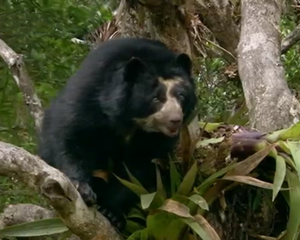The Andes Mountains in South America, home to this continent's only bear.
南美洲的安第斯山脉是这片大陆唯一的熊的家园。
White facial markings are a clue to its name, the spectacled bear.
面部的白色斑纹是它名字的标志——眼镜熊。
But to many of us, it's far more familiar as the storybook character of Paddington, who came all the way from darkest Peru.
但对我们很多人来说,我们更为熟知的是故事书里从最黑暗的秘鲁远道而来的角色帕丁顿。
Like is fictional counterpart, this bear has a sweet tooth.
和故事书里虚构的角色一样,这只熊也喜欢吃甜食。

Although in these cloud forests, marmalade sandwiches aren't an option.
不过在这片云雾缭绕的森林里,果酱三明治是不可能吃到的。
Fortunately, there's another high-calorie food here.
幸运的是,这里还有另外一种高热量食物。
Bromeliads, a family of plants that includes the pineapple.
凤梨,即一科包括菠萝在内的植物。
Perched yards off the ground, they're out of reach for most large mammals.
眼镜熊栖息在离地面几码远的地方,这使得多数大型哺乳动物都够不着它们。
Bromeliads are notoriously robust plants, but the spectacled bear can break them apart with ease.
凤梨是出了名的粗壮植物,但眼镜熊能够轻易将它们折断。
That's because relative to its size, it has the largest jaw muscle of any bear species
这是因为相对于它的体型,它拥有所有熊类中最大的颚肌
and grinding teeth that are secured into its jaws with three roots instead of two.
以及三根而不是两根固定在颚上的磨牙。
It's after the sugar-rich core.
它以富含糖分的凤梨芯儿为食。
The spectacled bear will also eat palm nuts, birds' eggs, and small animals,
眼镜熊也吃棕榈坚果、鸟蛋和小动物,
but half of its diet is made up of these high-energy plants.
不过这些高能量植物占据了它们一半的食物。











